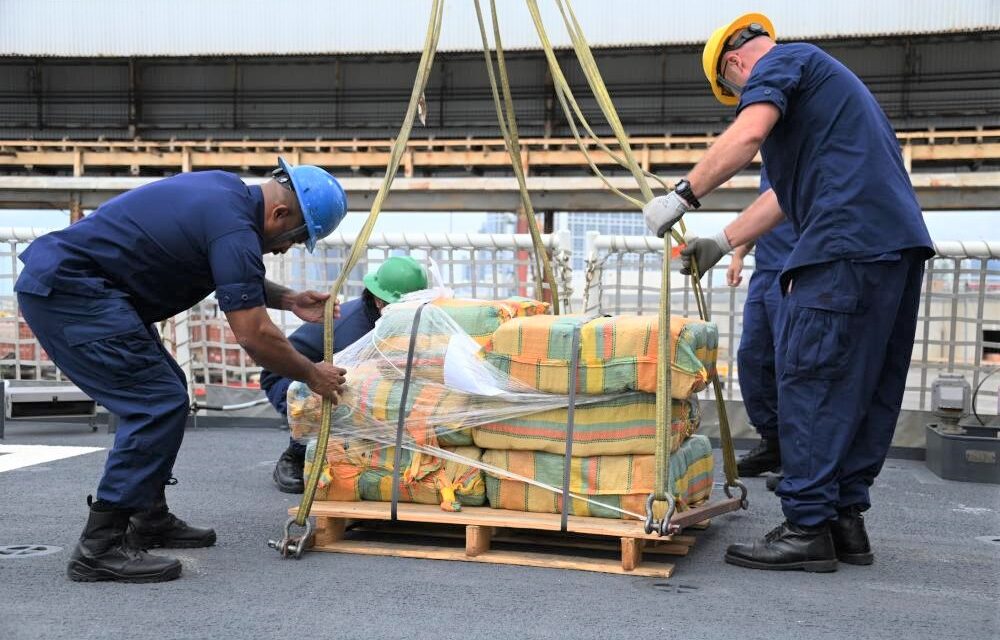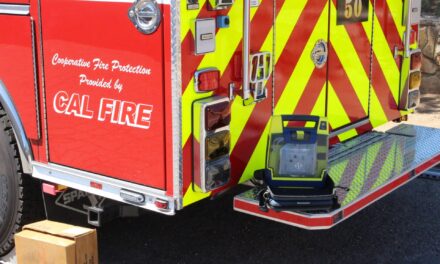
San Diego, CA–The Coast Guard Cutter Kimball (WMSL 756) crew offloaded more than 11,300 pounds of cocaine and more than 4,000 pounds of marijuana worth more than $223 million Thursday in San Diego.
The drugs were interdicted in international waters of the Eastern Pacific Ocean off the coasts of Central and South America, including contraband seized and recovered during eight interdictions of suspected drug smuggling vessels between late February and early March.
“At-sea interdictions of pure cocaine are the most effective way to limit cartel’s destabilizing effects throughout the Western Hemisphere,” said Vice Admiral Michael McAllister, Coast Guard Pacific Area commander. “Coast Guard national security cutters like Kimball are the service’s most capable asset to strengthen maritime governance, but when team partners from the Royal Canadian Navy and U.S. Navy Littoral combat ships they leverage our network of international and interagency partners to reduce the availability of illicit drugs in the Western Hemisphere and facilitate U.S. Attorney’s efforts to close the cycle of justice.”
The drugs were interdicted by the following ships:
The total amount listed below is 11,301 pounds of cocaine and 4,076 pounds of marijuana.
- Kimball’s crew was responsible for one interdiction seizing approximately 2,295 pounds of cocaine.
- Coast Guard Cutter Legare’s (WMEC 912) crew was responsible for four interdictions, seizing approximately 4,714 pounds of cocaine and 1,826 pounds of marijuana.
- Coast Guard Cutter Spencer’s (WMEC 905) crew was responsible for one interdiction seizing approximately 635 pounds of cocaine and 2,250 pounds of marijuana.
- Jointly, Her Majesty’s Canadian Ship Yellowknife (MM 706) and Kimball’s crews were responsible for one interdiction, seizing approximately 331 pounds of cocaine.
- The crews of the Kimball and Legare were responsible for one interdiction, seizing approximately 3,326 pounds of cocaine.
“This marks the first of likely many counter-drug patrols for Kimball and I am extremely proud of our crew’s preparation and hard work to make this an extremely successful deployment. Kimball’s crew demonstrated that through teamwork we were able to remove over $100 million dollars of cocaine, preventing it from ever crossing our borders or entering our neighborhoods, and further removing a source of illicit revenue from transnational criminal networks,” said Capt. Thomas D’Arcy, commanding officer of the Kimball.
Numerous U.S. agencies from the Departments of Defense, Justice, and Homeland Security cooperated in the effort to combat transnational organized crime. The Coast Guard, Navy, Customs and Border Protection, Federal Bureau of Investigation, Drug Enforcement Administration, and Immigration and Customs Enforcement, along with allied and international partner agencies, play a role in counter-drug operations.
The fight against drug cartels in the Eastern Pacific Ocean requires unity of effort in all phases from detection, monitoring, and interdictions, to criminal prosecutions by international partners and U.S. Attorneys’ Offices in districts across the nation. The law enforcement phase of counter-smuggling operations in the Eastern Pacific Ocean is conducted under the authority of the 11th Coast Guard District, headquartered in Alameda. The interdictions, including the actual boardings, are led and conducted by members of the U.S. Coast Guard.
“Interdictions in the Eastern Pacific are critical to targeting and prosecuting transnational criminal organization leaders and violent criminals. The efforts of Coast Guard cutters and supporting assets prevent the sale and future distribution of hundreds of metric tons of cocaine a year, with seizures of vast amounts of drugs at unprecedented levels. As transnational criminal organizations continue to evolve, so too must our efforts to find them and bring them to justice. It is only by law enforcement and prosecutors working in close coordination that we achieve our common goal of justice,” explained Randy Grossman, U.S. Attorney for the Southern District of California.
The Kimball is a 420-foot Legend-Class National Security Cutter and is homeported in Honolulu, Hawaii. With a range of 13,000 nautical miles, the advanced technologies of this class are designed to support the national objective to maintain the security of America’s maritime boundaries and provide long-range search and rescue capabilities. The Legare is a 270-foot Medium Endurance Cutter and is homeported in Portsmouth, Va. The Spencer is a 270-foot Medium Endurance Cutter and is homeported in Portsmouth, Va. The Yellowknife is a 181-foot Kingston Class Coastal Defense Vessel and is homeported in Esquimalt, British Columbia.



